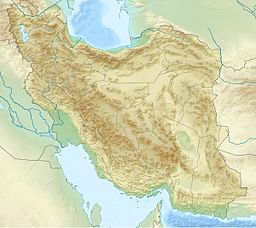Zabol (flygplats)
| Den här artikeln har skapats av Lsjbot, ett program (en robot) för automatisk redigering. (2016-09) Artikeln kan innehålla fakta- eller språkfel, eller ett märkligt urval av fakta, källor eller bilder. Mallen kan avlägsnas efter en kontroll av innehållet (vidare information) |
| Zabol (فرودگاه زابل) | |
| Forūdgāh-e Zābol | |
| Flygplats | |
| Land | |
|---|---|
| Höjdläge | 496 m ö.h. |
| Koordinater | 31°05′54″N 61°32′38″Ö / 31.09833°N 61.54389°Ö |
| Tidszon | IRST (UTC+3:30) |
| - sommartid | IRDT (UTC+4:30) |
| IATA-kod | ACZ |
| ICAO-kod | OIZB |
| Geonames | 6300083 |
Läge i Iran | |
Zabol (persiska: فرودگاه زابل, Forūdgāh-e Zābol) är en flygplats i Iran.[1] Den ligger i den östra delen av landet, 1 100 km sydost om huvudstaden Teheran. Zabol ligger 496 meter över havet.[1]
Terrängen runt Zabol är mycket platt.[a] Zabol är den högsta punkten i trakten. Runt Zabol är det ganska tätbefolkat, med 67 invånare per kvadratkilometer.[3] Närmaste större samhälle är Zābol, 8,8 km sydväst om Zabol. Trakten runt Zabol är ofruktbar med lite eller ingen växtlighet.[4]
I trakten råder ett hett ökenklimat.[5] Årsmedeltemperaturen i trakten är 24 °C. Den varmaste månaden är juli, då medeltemperaturen är 36 °C, och den kallaste är januari, med 9 °C.[6] Genomsnittlig årsnederbörd är 117 millimeter. Den regnigaste månaden är februari, med i genomsnitt 26 mm nederbörd, och den torraste är juni, med 1 mm nederbörd.[7]
| Zabol | ||||||||||||||||||||||||||||||||||||||||||||||||||||||||||||
|---|---|---|---|---|---|---|---|---|---|---|---|---|---|---|---|---|---|---|---|---|---|---|---|---|---|---|---|---|---|---|---|---|---|---|---|---|---|---|---|---|---|---|---|---|---|---|---|---|---|---|---|---|---|---|---|---|---|---|---|---|
| Klimatdiagram (förklaring) | ||||||||||||||||||||||||||||||||||||||||||||||||||||||||||||
| ||||||||||||||||||||||||||||||||||||||||||||||||||||||||||||
Kommentarer
Källor
- ^ [a b] Zabol hos Geonames.org (cc-by); post uppdaterad 2007-01-03; databasdump nerladdad 2016-08-15
- ^ ”Viewfinder Panoramas Digital elevation Model”. http://www.viewfinderpanoramas.org/dem3.html. Läst 21 juni 2015.
- ^ ”NASA Earth Observations: Population Density”. NASA/SEDAC. Arkiverad från originalet den 9 februari 2016. https://web.archive.org/web/20160209064446/http://neo.sci.gsfc.nasa.gov/view.php?datasetId=SEDAC_POP. Läst 30 januari 2016.
- ^ ”NASA Earth Observations: Land Cover Classification”. NASA/MODIS. Arkiverad från originalet den 28 februari 2016. https://web.archive.org/web/20160228161657/http://neo.sci.gsfc.nasa.gov/view.php?datasetId=MCD12C1_T1. Läst 30 januari 2016.
- ^ Peel, M C; Finlayson, B L; McMahon, T A (2007). ”Updated world map of the Köppen-Geiger climate classification”. Hydrology and Earth System Sciences 11: sid. 1633-1644. doi:. http://www.hydrol-earth-syst-sci.net/11/1633/2007/hess-11-1633-2007.html. Läst 30 januari 2016.
- ^ [a b] ”NASA Earth Observations Data Set Index”. NASA. Arkiverad från originalet den 7 april 2019. https://web.archive.org/web/20190407091601/https://neo.sci.gsfc.nasa.gov/dataset_index.php. Läst 30 januari 2016.
- ^ ”NASA Earth Observations: Rainfall (1 month - TRMM)”. NASA/Tropical Rainfall Monitoring Mission. Arkiverad från originalet den 11 maj 2020. https://web.archive.org/web/20200511075534/https://neo.sci.gsfc.nasa.gov/view.php?datasetId=TRMM_3B43M. Läst 30 januari 2016.
Media som används på denna webbplats
Robot icon
Flag of Iran. The tricolor flag was introduced in 1906, but after the Islamic Revolution of 1979 the Arabic words 'Allahu akbar' ('God is great'), written in the Kufic script of the Qur'an and repeated 22 times, were added to the red and green strips where they border the white central strip and in the middle is the emblem of Iran (which is a stylized Persian alphabet of the Arabic word Allah ("God")).
The official ISIRI standard (translation at FotW) gives two slightly different methods of construction for the flag: a compass-and-straightedge construction used for File:Flag of Iran (official).svg, and a "simplified" construction sheet with rational numbers used for this file.
Shiny red button/marker widget. Used to mark the location of something such as a tourist attraction.
Författare/Upphovsman: Uwe Dedering, Licens: CC BY-SA 3.0
Topographic map of the Iranian plateau in Central Asia, connecting to Anatolia in the west and Hindu Kush and Himalaya in the east.



